How to use vuejs slot
How to use vuejs slot: 1. Put some DOM in the sub-component; 2. Display or hide the DOM through slot, code such as "new Vue({el: "#app",data: {} ,components:{children:{...}}}) ”.

The operating environment of this article: Windows 7 system, vue version 2.9.6, DELL G3 computer.
Use of slots in vuejs
Overview:
If the parent component needs to put some DOM in the child component, then these DOM are Displaying or hiding, where to display, and how to display are all the responsibility of slot distribution.
Distributed in the following situations:

##
<p>
<children>
<span>我是slot内容</span> <!--这行不会显示-->
</children>
</p>
<script>
new Vue({
el: "#app",
data: {
},
components: {
children: { //这个无返回值,不会继续派发
template: "<button>为了明确作用范围,所以使用button标签"
}
}
}) </script>
Single slot:
<p>
<children>
<span>我是slot内容</span>
<!--这行不会显示-->
</children>
</p>
<script>
new Vue({
el: "#app",
data: {
},
components: {
children: { //这个无返回值,不会继续派发
template: "<button><slot>为了明确作用范围,所以使用button标签"
}
}
}) </script>
即父组件放在子组件里的内容,插到了子组件<slot></slot>位置;
注意:即使有多个标签,会一起被插入,相当于在父组件放在子组件里的标签,替换了<slot></slot>这个标签。
例如:<p>
<children>
<span>我是slot内容</span>
<p>测试测试</p>
<em>我是测试的</em>
<!--这行不会显示-->
</children>
</p>
<script>
new Vue({
el: "#app",
data: {
},
components: {
children: { //这个无返回值,不会继续派发 template: "<button><slot>为了明确作用范围,所以使用button标签"
}
}
}) </script>
D:具名slot:将放在子组件里的不同html标签放到不同位置,父组件在要发布的标签里添加slot=”name名”属性,子组件在对应分发的位置的slot标签里,添加name=”name名”属性,然后就会将对应的标签放在对应位置了。
例如:<p>
<children>
<span>12345</span>
<span>56789</span>
</children>
</p>
<script>
new Vue({
el: "#app",
data: {
},
components: {
children: { //这个无返回值,不会继续派发 template: "<button><slot name='first'>为了明确作用范围<slot name='third'>所以使用button标签"
}
}
}) </script>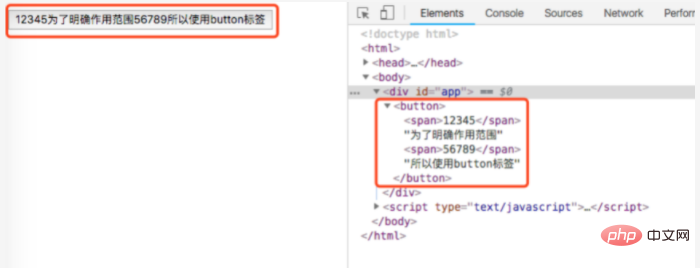
E:分发内容的作用域:
被分发的内容的作用域,根据其所在模块决定,例如:<p>
<children>
<span>12345</span>
<span>56789</span>
</children>
</p>
<script>
new Vue({
el: "#app",
data: {
},
components: {
children: { //这个无返回值,不会继续派发 template: "<button><slot name='first'>为了明确作用范围<slot name='third'>所以使用button标签"
}
},
methods: {
test: function() {
console.log("我是first点击打印的内容");
}
}
}) </script>点击按钮12345的区域时(而不是全部按钮),会触发父组件的test方法,然后打印“我是first点击打印的内容”。但是点击其他区域则没有影响。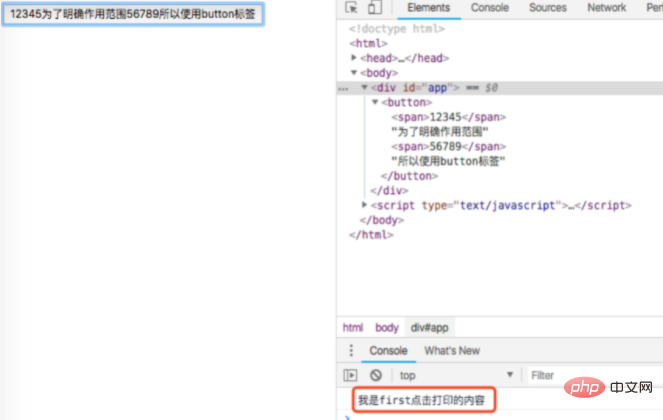
F:当没有分发内容时的提示:假如父组件没有在子组件中放置有标签,或者是父组件在子组件中放置标签,但有slot属性,而子组件中没有slot属性的标签。那么子组件的slot标签,将不会起任何作用。除非,该slot标签内有内容,那么在无分发内容的时候,会显示该slot标签内的内容。
例如:<p>
<children>
<span>【12345】</span>
</children>
</p>
<script>
new Vue({
el: "#app",
data: {
},
components: {
children: { //这个无返回值,不会继续派发 template: "<p><slot name='first'><button>【没内容显示1】为了明确作用范围,<slot name='last'><button>【没内容显示2】所以使用button标签"
}
}
}) </script>
如果改为:<p>
<children>
<span>【12345】</span>
</children>
</p>
<script>
new Vue({
el: "#app",
data: {
},
components: {
children: { //这个无返回值,不会继续派发 template: "<p><slot name='first'><button>【没内容显示1】为了明确作用范围,<slot name='last'><button>【没内容显示2】所以使用button标签"
}
}
}) </script>
说明:a、name=”first”的slot标签被父组件对应的标签所替换(slot标签内部的内容被舍弃)
b、name=”last”的slot标签,因为没有对应内容,则显示该slot标签内部的内容。
G、假如想控制子组件根标签的属性【1】首先,由于模板标签是属于父组件的,因此,将子组件的指令绑定在模板标签里,是不可以的(因为其归属于父组件)
【2】假如需要通过父组件控制子组件是否显示(例如v-show或v-if),那么这个指令显然是属于父组件的,可以将标签写在子组件的模板上。例如:<p>
<button>点击让子组件显示</button>
<children></children>
</p>
<script>
new Vue({
el: "#app",
data: {
abc: false
},
methods: {
toshow: function() { this.abc = !this.abc;
}
},
components: {
children: { //这个无返回值,不会继续派发 template: "<p>这里是子组件"
}
}
}) </script>
点击之后:
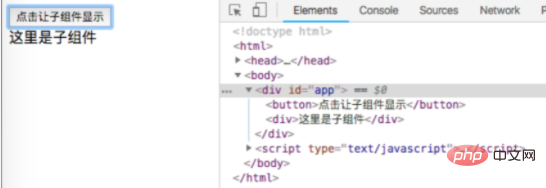
说明:通过父组件(点击按钮,切换v-if指令的值)控制子组件是否显示。
【3】假如需要通过子组件,控制子组件是否显示(比如隐藏)那么这个指令显然是属于子组件的(会将值放在子组件的data属性下)那么就必须放置在子组件的根标签中。
例如:<p>
<button>点击让子组件显示</button>
<children>
<span>【12345】</span>
<!--上面这行不会显示-->
</children>
</p>
<script>
new Vue({
el: "#app",
methods: {
toshow: function() { this.$children[0].tohidden = true;
}
},
components: {
children: { //这个无返回值,不会继续派发 template: "<p v-if='tohidden' @click='tohide'>这里是子组件",
data: function() { return {
tohidden: true
}
},
methods: {
tohide: function() { this.tohidden = !this.tohidden;
}
}
}
}
}) </script>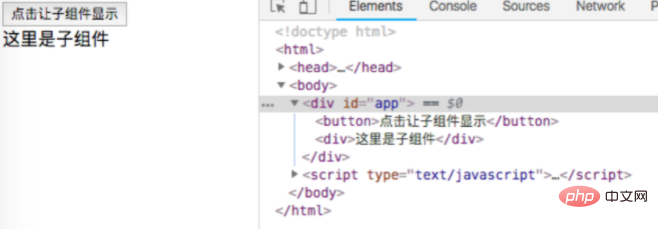 ##Click "Here are the child components "After:
##Click "Here are the child components "After:
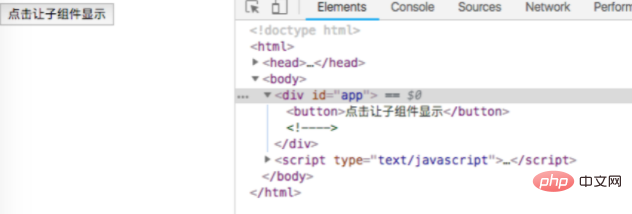 Click "Click to make the subcomponent display":
Click "Click to make the subcomponent display":
Click the button of the parent component to redisplay the child component by changing the tohidden attribute of the child component. 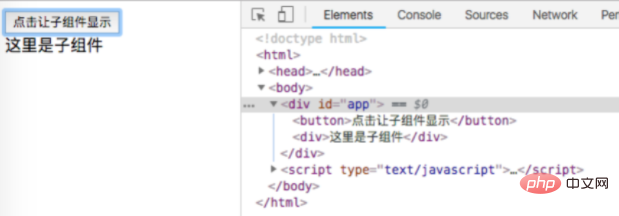 The instructions of the subcomponent are bound to the template of the subcomponent (so they can be called).
The instructions of the subcomponent are bound to the template of the subcomponent (so they can be called).
Recommended learning: "
The above is the detailed content of How to use vuejs slot. For more information, please follow other related articles on the PHP Chinese website!

Hot AI Tools

Undresser.AI Undress
AI-powered app for creating realistic nude photos

AI Clothes Remover
Online AI tool for removing clothes from photos.

Undress AI Tool
Undress images for free

Clothoff.io
AI clothes remover

AI Hentai Generator
Generate AI Hentai for free.

Hot Article

Hot Tools

Notepad++7.3.1
Easy-to-use and free code editor

SublimeText3 Chinese version
Chinese version, very easy to use

Zend Studio 13.0.1
Powerful PHP integrated development environment

Dreamweaver CS6
Visual web development tools

SublimeText3 Mac version
God-level code editing software (SublimeText3)

Hot Topics
 1378
1378
 52
52
 In-depth discussion of how vite parses .env files
Jan 24, 2023 am 05:30 AM
In-depth discussion of how vite parses .env files
Jan 24, 2023 am 05:30 AM
When using the Vue framework to develop front-end projects, we will deploy multiple environments when deploying. Often the interface domain names called by development, testing and online environments are different. How can we make the distinction? That is using environment variables and patterns.
 What is the difference between componentization and modularization in vue
Dec 15, 2022 pm 12:54 PM
What is the difference between componentization and modularization in vue
Dec 15, 2022 pm 12:54 PM
The difference between componentization and modularization: Modularization is divided from the perspective of code logic; it facilitates code layered development and ensures that the functions of each functional module are consistent. Componentization is planning from the perspective of UI interface; componentization of the front end facilitates the reuse of UI components.
 Detailed graphic explanation of how to integrate the Ace code editor in a Vue project
Apr 24, 2023 am 10:52 AM
Detailed graphic explanation of how to integrate the Ace code editor in a Vue project
Apr 24, 2023 am 10:52 AM
Ace is an embeddable code editor written in JavaScript. It matches the functionality and performance of native editors like Sublime, Vim, and TextMate. It can be easily embedded into any web page and JavaScript application. Ace is maintained as the main editor for the Cloud9 IDE and is the successor to the Mozilla Skywriter (Bespin) project.
 Practical combat: Develop a plug-in in vscode that supports vue files to jump to definitions
Nov 16, 2022 pm 08:43 PM
Practical combat: Develop a plug-in in vscode that supports vue files to jump to definitions
Nov 16, 2022 pm 08:43 PM
vscode itself supports Vue file components to jump to definitions, but the support is very weak. Under the configuration of vue-cli, we can write many flexible usages, which can improve our production efficiency. But it is these flexible writing methods that prevent the functions provided by vscode itself from supporting jumping to file definitions. In order to be compatible with these flexible writing methods and improve work efficiency, I wrote a vscode plug-in that supports Vue files to jump to definitions.
 Let's talk in depth about reactive() in vue3
Jan 06, 2023 pm 09:21 PM
Let's talk in depth about reactive() in vue3
Jan 06, 2023 pm 09:21 PM
Foreword: In the development of vue3, reactive provides a method to implement responsive data. This is a frequently used API in daily development. In this article, the author will explore its internal operating mechanism.
 Explore how to write unit tests in Vue3
Apr 25, 2023 pm 07:41 PM
Explore how to write unit tests in Vue3
Apr 25, 2023 pm 07:41 PM
Vue.js has become a very popular framework in front-end development today. As Vue.js continues to evolve, unit testing is becoming more and more important. Today we’ll explore how to write unit tests in Vue.js 3 and provide some best practices and common problems and solutions.
 A simple comparison of JSX syntax and template syntax in Vue (analysis of advantages and disadvantages)
Mar 23, 2023 pm 07:53 PM
A simple comparison of JSX syntax and template syntax in Vue (analysis of advantages and disadvantages)
Mar 23, 2023 pm 07:53 PM
In Vue.js, developers can use two different syntaxes to create user interfaces: JSX syntax and template syntax. Both syntaxes have their own advantages and disadvantages. Let’s discuss their differences, advantages and disadvantages.
 A brief analysis of how vue implements file slicing upload
Mar 24, 2023 pm 07:40 PM
A brief analysis of how vue implements file slicing upload
Mar 24, 2023 pm 07:40 PM
In the actual development project process, sometimes it is necessary to upload relatively large files, and then the upload will be relatively slow, so the background may require the front-end to upload file slices. It is very simple. For example, 1 A gigabyte file stream is cut into several small file streams, and then the interface is requested to deliver the small file streams respectively.




